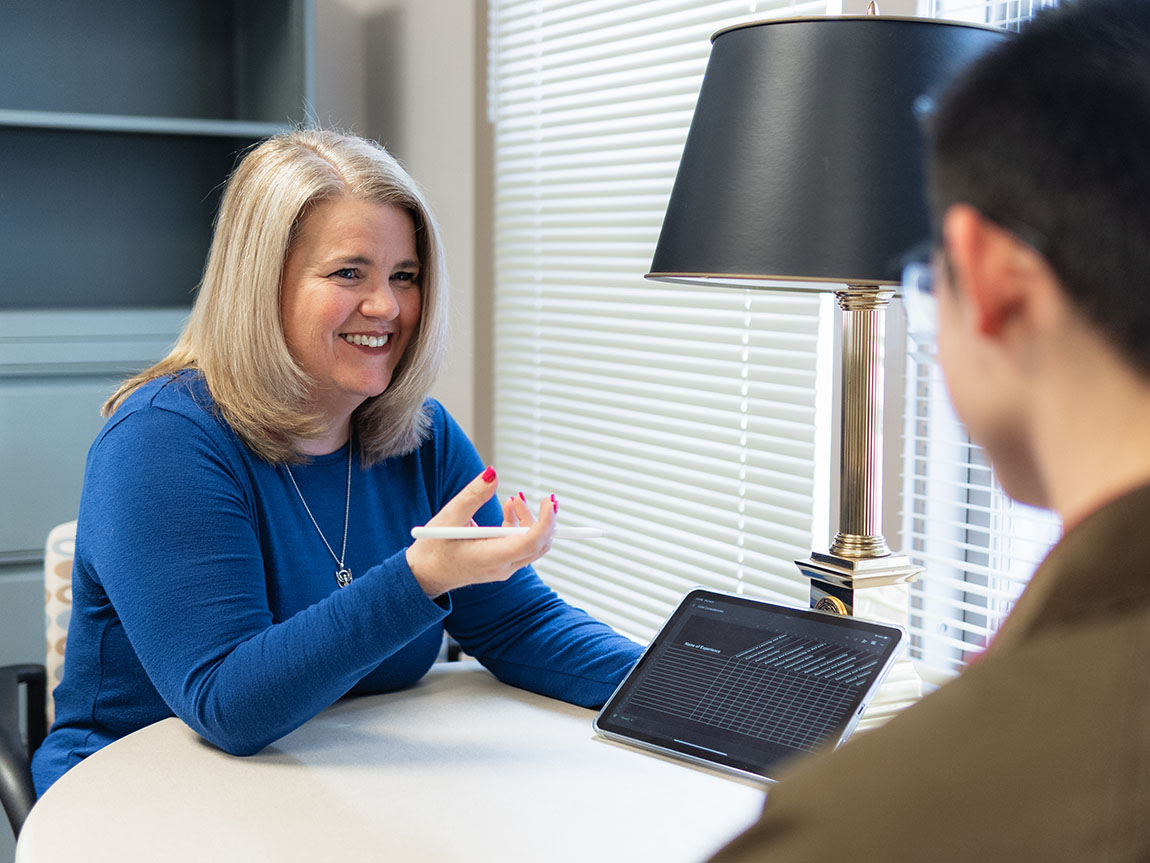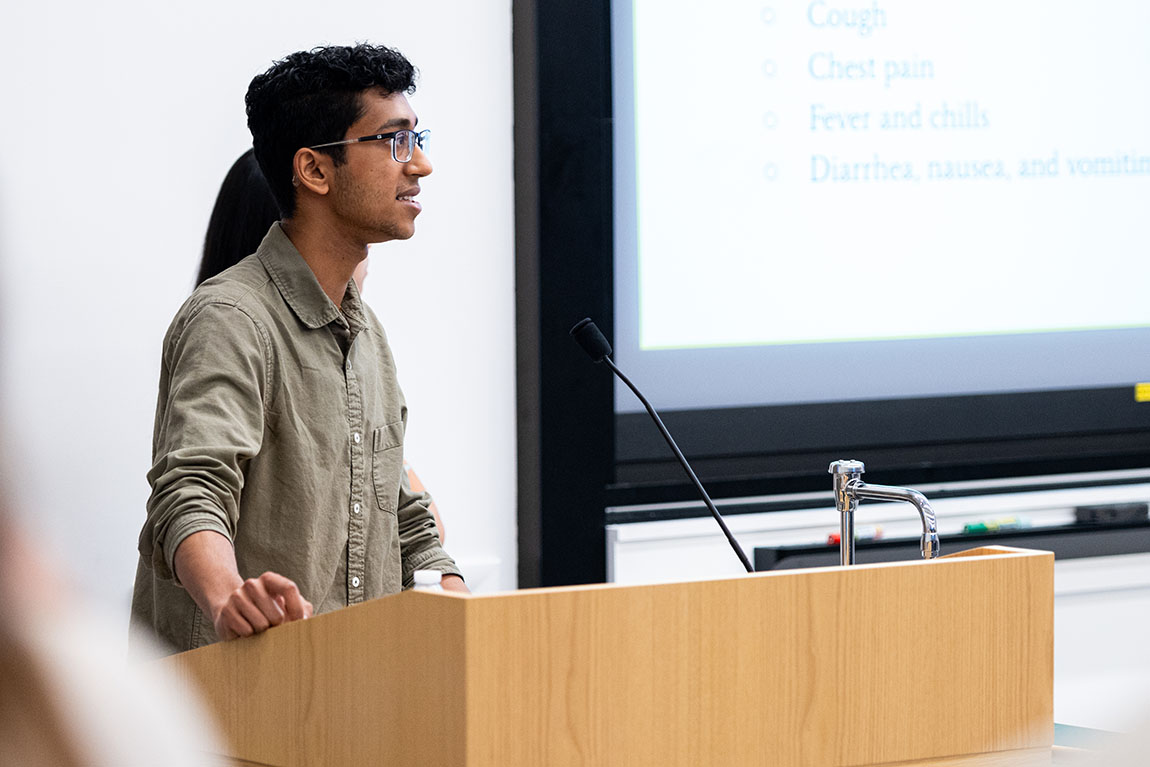Muhlenberg Offers Innovative Mock Application Process for Prehealth Students
The process, which now stretches over an entire academic year, challenges each student to create the strongest application they can and produces powerful results.By: Meghan Kita Wednesday, February 14, 2024 00:32 PM
 Director of Health Professions Advising Cailín Cordon-Waldman speaks with a student. Photos by Joe Romano ’23
Director of Health Professions Advising Cailín Cordon-Waldman speaks with a student. Photos by Joe Romano ’23So far, Raivat Shah ’23, a premed biology and anthropology double major, has been accepted to the University of Michigan Medical School, the Emory University School of Medicine, the Lewis Katz School of Medicine at Temple University and the Cooper Medical School of Rowan University. He’s still waiting to hear from a few more before he chooses where to matriculate this fall. “I truly would not be in this position if it wasn’t for the mentorship I’ve received at Muhlenberg,” he says.
Shah cites Director of Health Professions Advising Cailín Cordon-Waldman and her unique mock application process as a major factor in his success. At many institutions, prehealth students complete a mock application to gain letters of recommendation from their school’s evaluative committee. At Muhlenberg, “the purpose is different,” Cordon-Waldman says. “The purpose is not to get the committee letter, even though that’s one result. The purpose is to build a really strong application. My focus is to help [students] create an application that’s going to be the best representation of who they are and what they have to offer.”
And it works: Over the past five years, 92 percent of all graduates who applied to medical and dental school were admitted.

Shah presenting his undergraduate research in summer 2021
Cordon-Waldman designed a curriculum around the mock application that’s open to all prehealth students, including those interested in medical, dental, veterinary and physician assistant programs, among others, as well as alumni who’ve taken a gap year (or a few). Starting in Fall 2022, she elongated the curriculum to stretch over an entire academic year.
The first goal of the curriculum is to help students assess their readiness: “It’s always been our philosophy that you apply when you’re the best applicant you can be,” she says. Because all prehealth students must apply a year before they intend to matriculate, students who envision going straight from Muhlenberg to those programs must apply at the end of their junior year. Students’ senior-year accomplishments — research and shadowing experiences, leadership positions in campus organizations, capstone projects — can only appear on the application if they plan on a gap year after Muhlenberg.
“The purpose is to build a really strong application. My focus is to help [students] create an application that’s going to be the best representation of who they are and what they have to offer.”
—Cailín Cordon-Waldman
Cordon-Waldman’s curriculum kicks off with a fall presentation that details what a strong application looks like. The semester continues with assignments that break the mock application down into manageable pieces. Students are asked to write an autobiography that tells their whole story, not just the “why I want to be a doctor” story, which will inform the personal statement they will send to every school. The second assignment has students reflect on their strengths, their weaknesses, what draws them to the career and why they think they’re ready to apply. Then, students fill out a grid that has them consider how the experiences they’ve had in class, on campus and professionally align with the core competencies health professions students are expected to have.
“The rigor of the medical school application process should not be underestimated,” Shah says. “As someone who went through Cailín’s rings of fire, I can attest to the wisdom of her process. By breaking each component of the application into more digestible chunks over several months, I was able to identify my weaknesses and hyper-develop those areas.”
He found the personal statement to be especially challenging — and, in the end, rewarding: “Although I love science and serving others (as everyone pursuing medicine does), I needed a way to articulate my journey to medicine that was compelling, authentic and reflective,” he says. “I learned that such personal realizations can only come with deliberate self-analysis and time. By being forced to begin my brainstorming several months before applying in addition to incorporating Cailín’s insights, I was able to craft a personal statement that garnered many compliments during the interview trail.”
Over the past five years, 92 percent of all graduates who applied to medical and dental school were admitted.
To help students develop a list of where to apply, Cordon-Waldman has them write a personal mission statement, one that details their values, the population they’d like to serve and their overall vision for their professional life. She then has the student compare their mission statement with those of five schools: “It’s much better, in my opinion, to apply to fewer schools you have targeted because you really match,” she says.
By the time the mock application is due in February, students have been given the time necessary to craft the strongest possible drafts. Between March and May, Cordon-Waldman meets with each applicant to provide final feedback and walk through the application process. That period is also when Muhlenberg’s evaluative committee does its work, and working so closely with applicants allows Cordon-Waldman to personalize her portion of the recommendation letter as much as the faculty do.
“Our faculty are amazing letter-writers. It’s very clear that they know the people they’re writing about,” she says. “Our process produces applications that are richer than those from other institutions.”
“The rigor of the medical school application process should not be underestimated. As someone who went through Cailín’s rings of fire, I can attest to the wisdom of her process. By breaking each component of the application into more digestible chunks over several months, I was able to identify my weaknesses and hyper-develop those areas.”
—Raivat Shah ’23
Shah would agree, and the acceptances he’s already received from esteemed medical schools serve as evidence.
“The mock application process forces you to deeply reflect on your core values, life purpose and your place in humanity … I was able to come away with a better understanding of who I am,” he says. “The mock application process, in my case, allowed me to think about how I can leverage my skills and interests to be of service to humanity and the greater good. For that, I am grateful.”
